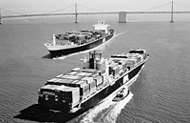
The converted tanker Ideal X leaves Newark, New Jersey, carrying fifty-eight cargo-laden truck trailers on its specially fitted deck. Containerization is born. Globalization sets sail.
The first containership was the brainchild of North Carolina trucking magnate Malcom McLean. He’d noted the wasted time of break-bulk cargo handling, with longshoremen laboriously loading individual crates and bales. He thought it made more sense to lift whole truck trailers on and off the ship. And he wanted to save taxes by avoiding the fees imposed for excess weight as a truck passed through various states.

McLean wanted to separate the truck container from its bed and wheels, and he conceived an angled-corner-post system to allow easy stacking and to hold the containers in place. He bought some old tankers and beta-tested his idea with the Ideal X. By the time the ship arrived in Houston, she already had space booked to ship containers north.
The savings began immediately, and they got bigger. Ports needed to retool and install new, jumbo cranes, but more and more did so as they saw other containerized ports increase traffic. Ships were built to contain nothing but containers, above deck and below. Containers were soon standardized to make the system global. In a classic effect, increasing the nodes in the network increased the value of every other part of the network.
About 90 percent of global cargo is now carried by container. The average cost of shipping a product overseas has fallen from 15 percent of retail to less than 1 percent. There’s less breakage and theft, but there is a downside. Ports handle more cargo but hire fewer dockworkers. And low-cost goods from overseas have eliminated millions of jobs in developed economies.
McLean was surely a visionary, but that doesn’t make him a saint.—RA